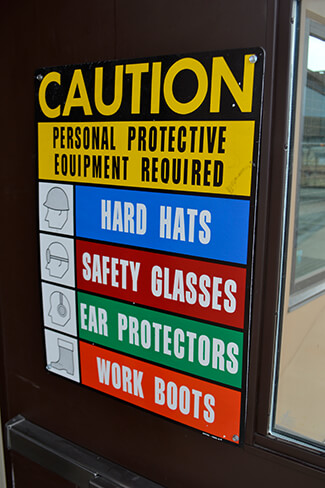5 Ways to Make Workplace Safety Signs Stand Out
03
February,
2023
3 MINUTE READ

There are signs along our path that if you miss or ignore, you could face harsh consequences. For example, driving 35 miles per hour in a 20 MPH zone can get you an expensive traffic ticket, or cutting metal without personal protective equipment can result in a painful eye injury. The purpose of a workplace safety sign is to inform workers and site visitors of what to do, where to go, and other significant messages for safety, efficiency, and compliance.
Are Signs Effective?
Yes, signs are essential in the workplace to appease Occupational Safety and Health Administration compliance. However, safety signs and labels are a practical and cost-effective tool for communication, training, security, hazard mitigation, and accident prevention. There are five types of signs that are used in the workplace and follow the ANSI Z535 standard. They are: danger, warning, caution, notice, and safety.
Earlier this year, a construction worker died after multiple contractors working on a project failed to conduct inspections to discover hazards, instruct employees on how to recognize workplace dangers, and install caution signs to warn workers about potential hazards, OSHA reported.
"Although safety signs and warnings are low on the hierarchy of controls, they are an important part of communicating with employees about the hazards in the workplace," said Diana Stegall of Rivendell Safety Consulting told ASSP.org for its article on the importance of workplace signs. "Signs that are well-positioned and take into consideration the hazard ?audience' can be very effective in communicating a hazard and serving as a reminder when no one else is around."
When used correctly and consistently, signs help workers stay safe and do their job correctly. For example, lockout tagout tags, temporary safety signs, and replacement labels and signs.
Strengthen Communication
 Can you think of a time when you needed a sign, and it wasn't there? How about times there was a sign, but it was too old, incorrect, or in a poor location? Facility managers have options to order pre-made safety signs and labels or custom create the signs and labels they need that are unique to their facility. No matter how signs and labels are obtained, here are five ways to have workplace safety signs that stand out:
Can you think of a time when you needed a sign, and it wasn't there? How about times there was a sign, but it was too old, incorrect, or in a poor location? Facility managers have options to order pre-made safety signs and labels or custom create the signs and labels they need that are unique to their facility. No matter how signs and labels are obtained, here are five ways to have workplace safety signs that stand out:
- Design: Simple signs provide basic information, but using images, varied text, etc., can make the message more relevant to workers. Try incorporating better sign creation using intuitive labeling software, which allows the inclusion of symbols and even company logos.
- Colors and text: Following ANSI's color standards for fire, traffic, and other notices are an essential part of effective signs. Make those color messages consistent throughout the facility. Also, make sure the text is readable, clear, and error-free.
- Texture and materials: Paper signs do not last and are not professional-looking. However, good signs go beyond aesthetics. They need to withstand certain surface textures as well, like stairs, walls, and metals. Account for humidity, ice, and other harsh working conditions such as UV light, cold storage, clean rooms, and low-light areas.
- Floor signs: Increase the visibility of a sign by its placement. While messages should be at eye level, floor signs can help reinforce those messages, especially in areas where traffic hazards are present.
- Training: Even with the best sign in the world, a worker must notice, adhere to, and understand them. Conduct frequent training and supervision to ensure signs are doing their job.
When it comes to safety signs in the workplace, where should managers start? Like all activities, start with an assessment and audit facility communication from top to bottom. When conducting a job hazard analysis, look at each step required to complete a job. Note any signs, labels, or other communication that can improve safety and efficiency. Also, look for signs that might need replacing or updating. Second, be consistent. When using a lean management system such as 5S, consistency is essential to program sustainment. Sustain is consistently the toughest S of the 5S system with which managers and workers say they have trouble.
New or additional signs are sometimes needed right away to alert people to a new hazard, further instructions, where to find something, or where to go. The last thing you want in your professional facility is a sloppy hand-written sign that downgrades your company's professionalism. For sign creation, facility management should consider the work environment, the audience, and whether the communication meets safety, compliance, and efficiency goals.
RELATED RESOURCES

NIOSH Study Links Workplace Noise, Heart Health
The National Institute of Occupational Safety and Health conducted a study about noise in the workplace and ...
Read
Biggest OSHA Sign Compliance Challenges
When it comes to signs in the workplace, opinions vary on why they are necessary and if they even work. One ...
Read
Do You Hear What I Hear? Tips for Conservation
Does your workplace have a hearing protection program? Use these simple tips to improve worker hearing ...
Read.png)


